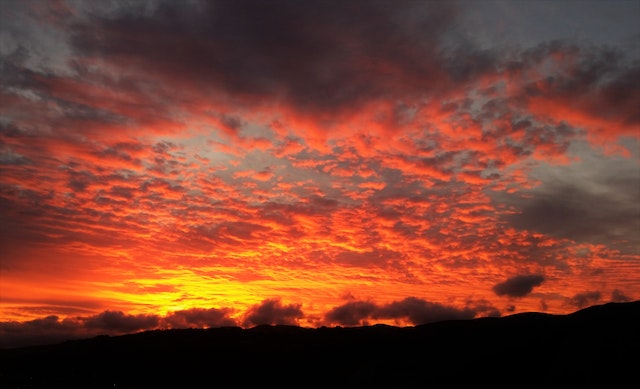
Why are sunsets such beautiful colors? The beautiful colors of sunrises and sunsets are caused because light rays are scattered by particles in the sky.
Light has different wavelengths and our eyes have evolved to detect these wavelengths, which is how we can see colors. Our eyes have a light-sensitive area which is sensitive to different wavelengths: blue – 450 nm – the shortest wavelength, green – 550 nm – in the middle, red – 650 nm – the longest wavelength. This light-sensitive area is called the retina and it is at the back of the eyeball. Light hits the front of the eye and is directed through the pupil. From there, the lens and the cornea focus the light on the retina at the back of the eye. The retina is covered in photoreceptors that turn the light into electrical signals. These photoreceptors are called rods and cones and different rods and cones respond to different light. Rods are used to detect low light and are used to detect movement. Cones are used to detect color. There are about 6 million cones in the eye and they are divided up into cones that detect long, medium, and short wavelengths of light. Each of the cones is stimulated by light, but the short cones are stimulated by short wavelengths and the long cones by long wavelengths. A wavelength of 550 nm stimulates the short cone. When the cones are stimulated, they send an electrical signal to the brain, which combines the information from the cells to make other colors. A wavelength that stimulates both the blue and the red cones (short and long) would be purple etc.
So, why are sunsets so many different colors? Well, let’s look at why the sky is blue first. During the day, the sun is directly overhead, and the light has a shorter journey to reach us. The air is full of particles and gases that get in the way of the light as it passes through the atmosphere. The short wavelengths of light are more likely to hit the particles than the long wavelengths are. The short wavelengths are the color we see as blue. These short wavelengths are scattered by the particles all over the sky and into our eyes, so we see the sky as blue.
Why are sunsets such beautiful colors? It is to do with distance. As the sun gets lower in the sky, the light has farther to travel to reach us. It also has far more of the atmosphere to travel through because of the angle. That means it has far more chance to interact with particles and gases. The first wavelength to get scattered is blue light because it is shortest. When the blue is scattered, it leaves the other wavelengths to continue. As the light continues through the atmosphere, more wavelengths are scattered. By the time the sun is low in the sky, the yellows and the reds, which are the longest wavelengths, are the only ones that haven’t yet been scattered. This is why the sky appears orange and red. Next time you look at the blue sky at lunchtime, remember that what you are seeing as a blue sky is the start of someone else’s sunset.
The clouds also play a large part in how beautiful the sunset is. The clouds reflect the sunlight down towards the ground and making the light appear more vivid. The best clouds are higher in the sky because low-level clouds will intercept the light waves.
The sky also needs to be clear. A lot of pollution and particles in the air will scatter the light too much and reduce the brightness of the sunset. This is why some of the best sunsets are seen in the late autumn and winter. When there is cold air close to the ground, there is usually a layer of warm air on top of it, like a lid. This pushes most of the pollution in the air down towards the ground, leaving the upper atmosphere clear. When there is less pollution, the light waves are scattered less and the sunsets are even more beautiful.
So, why are sunsets such beautiful colors? Because the amount of the atmosphere the light has to travel through increases as the sun sinks in the evening, increasing the amount of particles the light can interact with. And this is what I learned today.
Sources
https://scied.ucar.edu/learning-zone/air-quality/how-weather-affects-air-quality
https://spaceplace.nasa.gov/blue-sky/en/
https://www.rmg.co.uk/stories/topics/why-sky-blue
https://en.wikipedia.org/wiki/Cone_cell
https://askabiologist.asu.edu/rods-and-cones
https://www.amnh.org/explore/ology/brain/seeing-color
https://en.wikipedia.org/wiki/Sunset
https://www.wrtv.com/weather/all-eyes-on-the-horizon-heres-why-our-sunsets-have-been-so-colorful
https://www.reconnectwithnature.org/news-events/the-buzz/the-science-of-sunsets/
